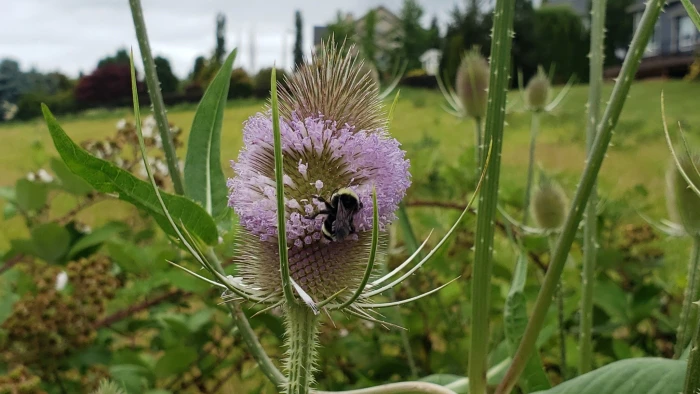Wild Teasel
(Dipsacus fullonum)
Wild Teasel (Dipsacus fullonum)
/
/

Gavin Slater
CC BY 4.0
Image By:
Gavin Slater
Recorded By:
Copyright:
CC BY 4.0
Copyright Notice:
Photo by: Gavin Slater | License Type: CC BY 4.0 | License URL: http://creativecommons.org/licenses/by/4.0/ | Rights Holder: Gavin Slater | Publisher: iNaturalist | Date Created: 2021-07-01T12:30:31-07:00 |
























Estimated Native Range
Climate Requirements for Allendale, Michigan
| This Plant | Your Site | Plant Suitability for Your Location | ||
|---|---|---|---|---|
| • Precipitation | 1" - 118" | 35" | Your precipitation may be too high for this plant. | Too high |
| • High Temp. | 55°F - 99°F | 82°F | Your summer temperatures are normal for this plant. | Excellent |
| • Low Temp. | -13°F - 74°F | 16°F | Your winter temperatures are normal for this plant | Excellent |
This plant may not grow well at your location - your precipitation is too high.
Summary
Dipsacus fullonum, commonly known as wild teasel, is a biennial herb native to grasslands, roadsides, and disturbed areas in Eurasia and North Africa. It has been introduced to the Americas, southern Africa, Australia, and New Zealand. Wild teasel typically grows 3-8 feet tall and features prickly stems and leaves. The cylindrical lavender flower heads bloom from July to August and are highly attractive to bees and butterflies. The flower heads have been historically used in textile manufacturing for fulling cloth.
Wild teasel is valued for its architectural form and is sometimes used in dried flower arrangements. It is not commonly cultivated in gardens due to its invasive nature but can be found in naturalistic plantings and wildlife gardens. It prefers full sun to part shade and can grow in a variety of soil types, provided they are well-drained. While it can tolerate drought, moderate water will support more robust growth. Caution is advised when planting wild teasel, as it can become invasive outside its native range, outcompeting native vegetation and altering ecosystems.CC BY-SA 4.0
Wild teasel is valued for its architectural form and is sometimes used in dried flower arrangements. It is not commonly cultivated in gardens due to its invasive nature but can be found in naturalistic plantings and wildlife gardens. It prefers full sun to part shade and can grow in a variety of soil types, provided they are well-drained. While it can tolerate drought, moderate water will support more robust growth. Caution is advised when planting wild teasel, as it can become invasive outside its native range, outcompeting native vegetation and altering ecosystems.CC BY-SA 4.0
Plant Description
- Plant Type: Herb
- Height: 3-7 feet
- Width: 1.5-3 feet
- Growth Rate: Rapid
- Flower Color: Pink, Purple
- Flowering Season: Summer, Fall
- Leaf Retention: Deciduous
Growth Requirements
- Sun: Full Sun
- Water: Medium
- Drainage: Medium, Slow
Common Uses
Border Plant, Drought Tolerant
Natural Habitat
Grasslands, roadsides, and disturbed areas in Eurasia and North Africa
Other Names
Common Names: Wild Teasel, Common Teasel, Wilde Karde
Scientific Names: Dipsacus fullonum, Dipsacus arcimusci, Dipsacus botterii, Dipsacus botterii, Dipsacus carminatorius, Dipsacus connatofolius, Dipsacus divaricatus, Dipsacus fullonum, Dipsacus fullonum f. ternatus
GBIF Accepted Name: Dipsacus fullonum